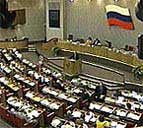
Law of RF On Election to the State Duma: Regional Aspects

 On October 25 after the second readings the State Duma authorized the Federal Law «On Elections of the Deputies to the State Duma of the Federal Assembly of the Russian Federation». In our previous bulletin we already reported about the centrists' initiative on raising the threshold for political parties up to 12,5%. According to the leader of «Regions of Russia» political group Oleg Morozov, this initiative was aimed at preparing the public opinion to raising the threshold up to more realistic 7%. The «OVR» faction in the persons of A. Isayev, F. Gainullina and K. Kosachyov attempted another «coup d'essai» by introducing an amendment earlier in October, suggesting to raise the threshold up to 7% for electoral blocs only. However, this amendment did not receive any serious discussion, as it was a violation of the principle of equality between electoral blocs and electoral associations. On October 25 after the second readings the State Duma authorized the Federal Law «On Elections of the Deputies to the State Duma of the Federal Assembly of the Russian Federation». In our previous bulletin we already reported about the centrists' initiative on raising the threshold for political parties up to 12,5%. According to the leader of «Regions of Russia» political group Oleg Morozov, this initiative was aimed at preparing the public opinion to raising the threshold up to more realistic 7%. The «OVR» faction in the persons of A. Isayev, F. Gainullina and K. Kosachyov attempted another «coup d'essai» by introducing an amendment earlier in October, suggesting to raise the threshold up to 7% for electoral blocs only. However, this amendment did not receive any serious discussion, as it was a violation of the principle of equality between electoral blocs and electoral associations.
The main idea was worded by the Deputy Head of the President's Administration V. Surkov and by the Council of Federation Speaker S. Mironov: the threshold has to be raised to 7% for all the players, though not at the nearest elections, but the next nearest ones. Central Election Commission Chairman A. Veshnyakov, who happens to represent the President of RF for this particular Federal Law draft, shared the same view on the issue. Besides, Veshnyakov suggested to introduce another clause, stipulating that in case fewer than 4 parties or blocs will overcome the 7% threshold, the next closest party/bloc should be allowed into the State Duma, so that the number of political parties represented in the lower chamber of the Russian parliament is not fewer than 4 (the currently valid legislation has similar clause for the case of fewer than two parties overcoming the 5% threshold, and the similar clause regarding three parties is suggested for the Law on the nearest elections). The amendment itself was jointly initiated by the leaders of the four centrist factions and groups (V. Volodin, О. Morozov, V. Pekhtin, G. Raikov), by LDPR faction leader I. Lebedev and by the deputy leader of SPS faction B. Nadezhdin. This happened on October 16 (the deadline for initiating any amendments was over by September 1, however, the Committee for State Institutions and Systems is always indulgent regarding such kind of violations). This amendment received almost unanimous support at the Committee, only Sergei Popov of «Yabloko» was the one who voted against it. At the plenary session this amendment was supported by representatives of «Edinstvo», «OVR», Communists, LDPR, «People's Deputy» group. Sergei Mitrokhin from «Yabloko» was absolutely opposed to it. Oleg Smolin, representative of Agro-industrial group, also was against this amendment, emphasizing that it was his personal opinion. The Rightists Union («SPS») avoided the discussion. CEC Chairman A. Veshnyakov referred to this amendment as to «brief and fair». And after that it was accepted by 344 votes.
Besides the issue of raising the threshold several other issues were debated regarding some regional aspects pf elections to the State Duma. For example, B. Nadezhdin suggested to reject the principle, which requires that at least one single-mandate district is to be formed in every region. Implementation of such principle leads to a very uneven distribution of voters between election districts: from 782 thousand voters in Kurgan Oblast to 13 thousand in Evenkiysky Autonomous District. Back in 1998 this principle was contested at the Constitutional Court of the Russian Federation, however, the judges came to a conclusion that such dispensation of the equal voting rights principle in favor of the federalism principle is acceptable. B. Nadezhdin still believes, though, that the regions interests are guaranteed by their equal representation at the Council of Federations (the upper chamber), whereas for the State Duma it is more important to provide for equal representation of individual voters independent of the district in which they live.
While discussing this issue at the Committee for State Institutions and Systems it became clear that full implementation of B. Nadezhdin's amendment is impossible, because it may dangerously escalate the ethnic conflicts (in the Caucasus region especially). Then he suggested a compromise: the obligatory single-mandate districts are not to be formed in the subjects of the federation, which are part of other subjects of the federation. This amendment relates seven (out of ten) Autonomous Districts (AD): Chukotsky AD was singled out of Magadan Oblast back in 1992, and Khanty-Mansiysky and Yamalo-Nenetsky AD have got enough population to form wholesome election districts. This compromise variant of the amendment received support of the majority of the Committee. However, A. Veshnyakov did not agree with it and presented this amendment to be discussed at the plenary session and to be voted for separately. According to him, Nadezhdin's amendment violated the equality of the subjects and could be contested at the Constitutional Court. As a result, only 63 Duma members voted for it.
The clauses related to distinction between the federal part and the regional groups within the party list also provoked a lot of controversy. This kind of distinction was not required at the 1993 elections. The 1995 Law obliged electoral associations and blocs to single out regional groups in their lists, requiring the federal part not exceed 12 candidates. After the elections some claimed that the «Twelve Apostles» Rule had been a barrier to form major election blocs and had increased the fragmentation of political spectrum. As a result, the 1998 Law provided for the maximum of 18 candidates to be included into the federal part of the party list. However, this new clause led to the fact that in «Zhirinovsky Bloc» only candidates from the federal part were elected.
The developers of the new law draft recommended to lower the number of candidates in the federal part of the party lists down to nine. This was criticized as having no serious justification. B. Nadezhdin offered to lower the number down to three people. A. Isayev is for keeping the existing norm. I. Lebedev and O. Smolin suggested to raise the number up to 15, and F, Gainullina - up to 21. However, the majority was for going back to the old norm of 1995 Law - 12 candidates, such amendments were introduced by the Communists (CPRF), «Yabloko» and LDPR (Zhirinovsky), and were supported by the Committee for State Institutions and Systems and Veshnyakov. However, at the plenary session A. Isayev managed to get sufficient support for his own amendment - 301 votes despite Veshnyakov being against it.
One of the innovations of the new version of the law is the requirement for the party list to include at least seven regional groups. There wasn't any serious opposition to this. B. Nadezhdin, though, offered at the Committee session to eliminate the clause stipulating that the party is refused the registration for the elections in case due to the candidates' dropping-out there are less than 7 regional groups left in the list. However, this issue wasn't raised at the plenary session.
A. Saliy, the Head of the Working Group on preparing the draft for the second reading, and B. Nadezhdin tried to change the traditional order of distributing the mandates within a regional group - in accordance with the order the candidates are placed in the list. B. Nadezhdin offered to give each party the right to independently decide on the method of such distribution. However, this did not receive support, so Nadezhdin supported Saliy's amendments. Their main focus is that in case one of the leaders of a regional group is elected in the single-mandate district, the federal mandate this candidate is entitled to should be transferred not to the next candidate from the same list, but to the candidate representing the same region. According to Saliy and Nadezhdin, this could provide for more active participation in campaigning on behalf of the candidates placed at the bottom of the regional groups lists, as well as for raising the level of responsibility of regional parties branches.
This suggestion provoked long discussion at the Committee for State Institutions and Systems. Eventually it received support of the majority, and A. Veshnyakov was absolutely against it. Looks like it hasn't got unanimous support within the factions either: regional representatives viewed it more positively, while as the parties leaders considered it to be dangerous for their positions. Saliy's amendments were presented at the plenary session and received only 187 votes.
This article was published in «Russian Regional Bulletin»
issued by «East-West» Institute, №20, 2002.

|
